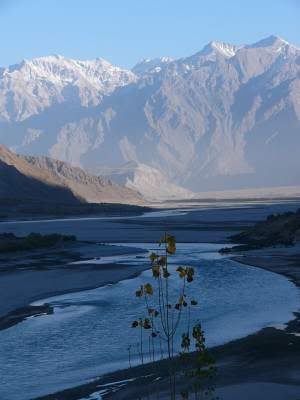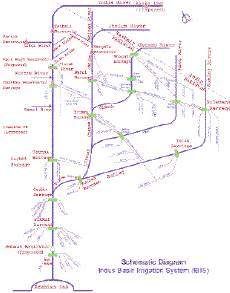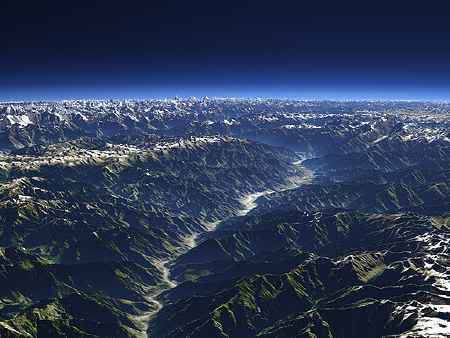Guest Post by Pervaiz Munir Alvi
The Punjab province of Pakistan is blessed with five major rivers and their numerous local tributaries. All of these five rivers originate from the snow capped peaks of the Himalayan Mountains.
After traveling hundreds of miles through the high mountain valleys, these rivers ultimately enter into the plains and plateaus of Punjab via the Frontier province of Pakistan, the State of Kashmir, and India.
In fact, Punjab owes its very name to these rivers as in Urdu/Persian languages the word simply means ‘five waters or five rivers’. Perhaps no other area in the world could claim that many major rivers flowing through it in that close proximity of each other. In that sense Punjab is unique. But what makes it further unique is its river link canal system first devised by the British in early twentieth century and then expanded by Pakistan under its Indus River Basin Water Management System. The complex Punjab Rivers and Link Canals System could very well be classified as one of the twentieth century engineering wonders.
The Indus (Sindh) is the northern and the upper most of the five rivers. The other four rivers named Jhelum, Chenab, Ravi and Sutlej follow the sequence. Waters of these rivers are managed through a vast system of large earthen dams and reservoirs, barrages and headworks, and, irrigation and link canals. Each river is linked to the next lower river through canals originating or ending at these waterworks and thus developing a grid of rivers and their link canals in the process.
 First major storage of Indus waters takes place at Tarbela Reservoir located just north of the boundary between Punjab and the Frontier Province. From this point on all the way down to the small town of Miran, with the exception of Kalabagh and Isa Khel areas, the River Indus roughly forms the boundary between Punjab and the Frontier Province. Within this course of the river numerous tributaries descending from the eastern slopes of the adjacent mountain ranges join the Indus. Most notable are the Kabul River that joins at Jahangira and Kurram River that joins at Kondal or Isa Khel. Both of these two relatively smaller rivers originate in Afghanistan and enter Pakistan via Frontier Province.
First major storage of Indus waters takes place at Tarbela Reservoir located just north of the boundary between Punjab and the Frontier Province. From this point on all the way down to the small town of Miran, with the exception of Kalabagh and Isa Khel areas, the River Indus roughly forms the boundary between Punjab and the Frontier Province. Within this course of the river numerous tributaries descending from the eastern slopes of the adjacent mountain ranges join the Indus. Most notable are the Kabul River that joins at Jahangira and Kurram River that joins at Kondal or Isa Khel. Both of these two relatively smaller rivers originate in Afghanistan and enter Pakistan via Frontier Province.
Similarly the waters of the next lower river, Jhelum, are stored at the Mangla Reservoir located at the boundary between Punjab and Pakistan controlled part of Kashmir known as Azad Kashmir. In fact River Jhelum as a north-south axis starting from Muzzafarabad, the capital of Azad Kashmir, to the city of Jhelum in Punjab forms the western boundary of the disputed state of Kashmir with Pakistan. From the city of Jhelum to the city of Khushab, the river flows westward just below the famous Salt Range.
 The plateau of Potohar forming the land mass between Indus and Jhelum in this area does not provide terrain favorable for link canals between these two rivers. As a result the first canal link between Indus and Jhelum rivers takes place pass the Salt Range via Chashma-Jhelum Link Canal originating from the rather grand Chashma Barrage on Indus River near the Town of Kundian. The first barrage at River Jhelum is located near the town of Rasul from where it is linked with the next lower river, Chenab, via Rasul-Qadirabad Link Canal. The River Jhelum ultimately falls into River Chenab near the town of Mudduki. The Trimmu Headworks on River Chenab is located at this juncture.
The plateau of Potohar forming the land mass between Indus and Jhelum in this area does not provide terrain favorable for link canals between these two rivers. As a result the first canal link between Indus and Jhelum rivers takes place pass the Salt Range via Chashma-Jhelum Link Canal originating from the rather grand Chashma Barrage on Indus River near the Town of Kundian. The first barrage at River Jhelum is located near the town of Rasul from where it is linked with the next lower river, Chenab, via Rasul-Qadirabad Link Canal. The River Jhelum ultimately falls into River Chenab near the town of Mudduki. The Trimmu Headworks on River Chenab is located at this juncture.
The River Chenab enters Punjab near the town of Akhnur in Indian held Kashmir. Marala Headworks is located at River Chenab near the town of Dhallewali. Khanki is the next headworks on River Chenab near the town of the same name. Next is the Qadirabad Barrage on River Chenab near the town of Rasulnagar. Each one of these three headworks/barrages plays a significant role in the river-canal link system in Punjab.
The next lower river, Ravi, from point Maddoke to point Sidhanwali in Punjab roughly zigzags between Pakistan and India before it is firmly inside Pakistan. The first link between Chenab and Ravi is via Marala-Ravi Link Canal and Bambanwala-Ravi-Bedian (B.R.B) Link Canal joining River Ravi at Sidhanwali above the town of Shahdara and Lahore, the capital of Punjab and one time capital of the vast Mughal Empire under Akbar the Great and then later under his son Jahangir. In fact Jahangir and his beloved Empress Noor Jahan are buried along the banks of River Ravi. The first headworks on River Ravi is at Balloki. The Upper Chenab Canal starting from Marala Headworks ultimately falls into River Ravi at Balloki Headworks. At the same time Qadirabad-Balloki Link Canal also connects the two rivers at the same location. The last canal link between Chenab and Ravi, before they merge together is via Trimmu-Sidhnai Link Canal ending at Sidhnai Barrage on River Ravi. From this merging point on the river continues under the name Chenab where Taunsa Barrage on River Indus provides the link between Indus and Chenab for the first time via Taunsa-Punjnud Link Canal near the historical city of Multan.
The last of the five rivers of Punjab roughly forms the border between Pakistan an d India for several miles before it is completely inside Pakistan. The B.R.B Link Canal from River Ravi is extended to meet River Sutlej along Pakistan-India border. Sulaimanke is the first headworks on River Sutlej. Here Ravi and Sutlej are linked for the second time via Balloki-Sulaimanke Link Canal. While Islam Headworks, also on Sutlej, does not provide any link, the next and the last link between Ravi and Sutlej takes place at Mailsi via Sidhnai-Mailsi Link Canal. Ultimately the River Sutlej joins the River Chenab and together form a body of water commonly known as Punjnad. A headworks of the same name is placed at this monumental location. Just below the Punjnad Headworks the waters from the lower four rivers would join the Indus River to complete the merger of the five rivers and their tributaries. From this point on the story of the five waters and their link canals in Punjab is passed on to the, one and only, mighty Indus River that would continue its journey through the Sindh Province of Pakistan till it will empty itself into the Arabian Sea.
d India for several miles before it is completely inside Pakistan. The B.R.B Link Canal from River Ravi is extended to meet River Sutlej along Pakistan-India border. Sulaimanke is the first headworks on River Sutlej. Here Ravi and Sutlej are linked for the second time via Balloki-Sulaimanke Link Canal. While Islam Headworks, also on Sutlej, does not provide any link, the next and the last link between Ravi and Sutlej takes place at Mailsi via Sidhnai-Mailsi Link Canal. Ultimately the River Sutlej joins the River Chenab and together form a body of water commonly known as Punjnad. A headworks of the same name is placed at this monumental location. Just below the Punjnad Headworks the waters from the lower four rivers would join the Indus River to complete the merger of the five rivers and their tributaries. From this point on the story of the five waters and their link canals in Punjab is passed on to the, one and only, mighty Indus River that would continue its journey through the Sindh Province of Pakistan till it will empty itself into the Arabian Sea.
Punjab Rivers and barrages/headworks (total=12):
Indus: Chashma, Taunsa
Jhelum: Rasul
Chenab: Marala, Khanki, Qadirabad, Trimmu
Ravi: Balloki, Sidhnai
Sutlej: Sulaimanke, Islam
Punjnad: Punjnad
River link canals in Punjab and rivers linked (total=10):
Chashma-Jhelum Link – Indus-Jhelum
Taunsa-Punjnad Link – Indus-Chenab
Rasul-Qadirabad Link – Jhelum-Chenab
Marala-Ravi Link – Chenab-Ravi
Bambanwala-Ravi-Bedian Link – Chenab-Ravi-Sutlej
Upper Chenab-Balloki Link – Chenab-Ravi
Qadirabad-Balloki Link – Chenab-Ravi
Trimmu-Sidhnai Link – Chenab-Ravi
Balloki-Sulaimanke Link – Ravi-Sutlej
Sidhnai-Mailsi Link – Ravi-Sutlej
Pervaiz Munir Alvi is a Ravian and trained as a Civil and Geo-technical Engineer.





















































Trish:
My father worked as a civil engineer, originally on the Sidhnai Barrage Project from its conception until completion; and later at Marala Barrage with a small firm of English consulting engineers. I have nothing but happy memories of my early childhood in Pakistan, from 1953 through until my father’s end of contract in 1968. From Lahore we would travel far up in to the beautiful himalayas, to places one can now only dream of visiting. Your country and its surrounds filled me with such pleasure and delight, I will treasure my memories for always.
My husband, an Australian, spent 5 years in the early 70’s, travelling mainly alone, through Bhutan, Kashmir, Nepal, Afghanistan, Pakistan and India and we are very lucky to have much film and slides he took during his travels.
It is such a shame that our (now adult) children can only experience travel to many of these parts of the world via photographs through souvenirs, postcards, and visions such as yours, displayed on the internet. So sad. Our world is becoming smaller and smaller, and more and more unsafe! Our young people are exploring less and less – for scientific research, as teachers, young professionals, aid agencies, etc etc.
Australia is now my home (since 1976) and we suffer much the same precarious problems with water shortage that Pakistan must do.
Interestingly, I remember my father commenting on what a wonderful addition to Pakistan the Indus River Irrigation Scheme would be for the future of its people.
Yes, ignorance can be bliss.
We Australians, too, prided ourselves in the construction of the Snowy Mountains River Project. The “Snowy River” now flows as a mere trickle. The Sydney City Metropolitan Warragamba Dam also pales in significance due to a huge increase in Sydney’s population, due mainly to migration.
We are, however, trying to work towards a “greener”, more sustainable future, but it is a VERY slow process, and expensive!
I work in a government high school which was completed in 2003. We harvest all the rain that falls on its roofs. All the buildings have wide overhang verandahs, and all walkways from building to building (including to the students’ bus collection bay at the front gate) are covered, harvesting the rain. All downpour flows into gutters and downpipes, which collects in huge underground tanks.
A large, trial, wind turbine has been installed with a view to pumping the water around the grounds. There is also a large dam/pond on the property which accommodates overflow from the tanks.
I think this is what we need to look towards for our future generation, because water is becoming so precious that without it, naturally, we cannot exist.
“Water Gives Life
Don’t Waste a Drop”.
Thank you for your interesting article.
Wow…wat a geography…
dats wat makes us think abt da nature nd da 1 whoz controlling all dat…Mashallah.
can any body give email address of tech school at Rasul,I am lookong for very old info circa1920 around
[quote comment=”6044″]oh Lord, geography!
God bless :P[/quote]……
ya i also believe that geography is such an boring subject its studieng as like as crossing a Big Sea.
Farrukh: All engineering projects have downside to them. One has to weigh the pluses and minuses of these projects. The relative economic prosperity, the power of the feudal lords, and the bulging population of Punjab, all ultimately are due to these rivers, canals and the land that goes with them. You are right, “Nature does not like to be messed with too much”. But the choice of do nothing will have its own consequences. Population control is one answer, but then again the ignorance of our people comes in the way. That’s why I say that education is the answer.